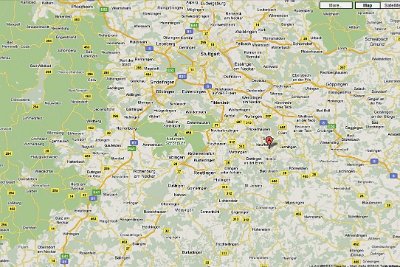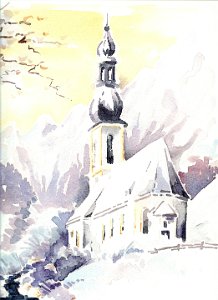 1 Thursday 15 July, 2010 Our next stop after visiting the Urwelt Museum is the ruins of the Hohenneuffen castle. It is located on a plateau of the Swabian Alps above the village of Neuffen and is a mere 25 kms away from Holzmaden. Stuttgart is to the North. |
 2 Thursday 15 July, 2010 We park the car at the top of the hill and start walking towards the castle. On the way we pass through a beautiful forest. |
 3 Thursday 15 July, 2010 European forests are distinctly different from Australian forests. They seem to be a brighter green and more lush but not more beautiful - just different. |
 4 Thursday 15 July, 2010 Then the going gets hard as we walk up the hill to the ruins. |
 5 Thursday 15 July, 2010 The castle is situated on a large late Jurassic rock on the edge of the Swabian Alb at an elevation of 743 m in a strategically advantageous location. |
 6 Thursday 15 July, 2010 The castle was built between 1100 and 1120 by Mangold von Sulmetingen who later changed his name to include von Neuffen. The first documentary evidence dates from 1198 and, at that time, the castle was still in possession of the von Neuffen family. |
 7 Thursday 15 July, 2010 The castle went into the possession of the Lords of Weinsberg at the end of the 13th century who sold it on to the Counts of Württemberg in 1301. The castle proved its worth in 1312 when, during strife within the Holy Roman Empire following the election of Henry VII as Holy Roman Emperor, it could not be conquered. |
 8 Thursday 15 July, 2010 Duke Karl Alexander of Württemberg planned to have Hohenneuffen altered into a fortress following the French model but he died (in 1737) before the task was completed. His successor, Karl Eugen abandoned the plan due to the high costs and the doubtful military benefit |
 9 Thursday 15 July, 2010 In 1793 it was decided to raze the castle and to sell off the building materials. The castle went out of use in 1795 and was finally destined for destruction in 1801. From 1830 onwards the remains of the castle were safeguarded from further destruction and in the 1860s public access to the ruin was allowed. |
 10 Thursday 15 July, 2010 The ruins are located in the Swabian Alps which is also called the Swabian Jura after the Jurassic period during which the bedrock of the mountains were laid on the ocean floor. Fossils can be found everywhere and children even find them in their backyards. Another castle can be seen on the next peak and yet another on the peak beyond. |
 11 Thursday 15 July, 2010 The Swabian Alps occupy the region bounded by the Danube in the southeast and the upper Neckar in the northwest. In the southwest it rises to the higher mountains of the Black Forest. The highest mountain of the region is the Lemberg (1015 m). |
 12 Thursday 15 July, 2010 Locals speak Swabian (Schwabisch) in a dialect that is often stronger than the rest of Swabia. In this region, many Swabian phrases and grammar are highly localized, even down to the village level. Nowadays, Swabia is a historical and linguistic region rather than a political one. |
 13 Thursday 15 July, 2010 The soil is not very fertile and the humus is often as thin as 10 cm. Many small limestone pebbles are found on the surface. Despite this, small farms are abundant. |
 14 Thursday 15 July, 2010 Looking to the north towards Stuttgart many small villages are visible. |
 15 Thursday 15 July, 2010 Before doing any sightseeing, we decide to have lunch first. When the waitress came, Jenni started to order in German. She spoke about two words and the waitress asked if she'd like an English menu. She persisted with the German menu while I ordered from the English one. |
 16 Thursday 15 July, 2010 After lunch, we go a little higher and admire the spectacular views. |
 17 Thursday 15 July, 2010 The castle walls were probably part of the partial restoration that took place in the twentieth century. |
 18 Thursday 15 July, 2010 The castle, as are other castles in the area, is built on a plateau. |
 19 Thursday 15 July, 2010 The view looking west towards the Black Forest. |
 20 Thursday 15 July, 2010 The village of Neuffen - population 6200 or so, elevation 408 metres. |
 21 Thursday 15 July, 2010 Jenni zoomed in to take this excellent close-up of Neuffen. |
 22 Thursday 15 July, 2010 A difference in Germany (compared with our own system) is the number of small private plots tended to by the villagers. Each hut belongs to a villager who looks after a particular plot. In the exact centre of the picture, you can see one hut that looks after a particular crop but the one to the right of it is a different crop. |
 23 Thursday 15 July, 2010 The geology of the Swabian Alps is mostly limestone, which formed on the seabed during the Jurassic era 200-150 million years ago. The sea receded 50 million years ago. Three layers of different limestone are stacked over each other to form the range: black jura, brown jura, and white jura. |
 24 Thursday 15 July, 2010 White jura may be as pure as 99% Calcium carbonate. Since limestone is soluble in water, rain seeps through cracks everywhere and forms subterranean rivers which flow through a large system of caves until they emerge. Thus there are hardly any rivers, lakes or other forms of surface water on the plateau. |
 25 Thursday 15 July, 2010 I take a photo of Jenni taking a picture of an heraldic emblem. It's not the emblem of Baden-Württemberg nor Swabia so my guess is that it's something to do with the von Neuffen family. |
 26 Thursday 15 July, 2010 This is the picture she took. |
 27 Thursday 15 July, 2010 Hohenneuffen was used as a holding place for enemies of the state where prisoners were held and, if deemed necessary, tortured. It was the Guantanamo of its day. On the orders of Duke Ulrich, the reeve (yes,yes) of Tübingen was held and tortured here before being beheaded in 1517 in Stuttgart. |
 28 Thursday 15 July, 2010 Historical note: During the Allied occupation of Germany, the prime minister of Württemberg-Baden (Reinhold Maier), invited the governments of Württemberg-Baden, Württemberg-Hohenzollern and Baden to a conference which took place on 2 August 1948 at Hohenneuffen Castle to discuss the formation of a new southwest state. |
 29 Thursday 15 July, 2010 Maier had chosen the place for the conference with care. The wide view from the top of the mountain, particularly onto the border of the occupation zones which ran between the district of Reutlingen and the then district of Nürtingen, was meant to impress the delegates. No agreement was reached at the end of the conference but it marked the beginning of a process which lead to the formation of Baden-Württemberg state. |
 30 Thursday 15 July, 2010 We walk down the hill from the castle and wait for Claus to walk up the next hill to the carpark. He got the car and drove back to collect us. He's such a nice man. |
 31 Thursday 15 July, 2010 Our next and final stop for the day is an historical village at the bottom of the hill. Looking back up, we can Hohenneuffen. |
 32 Thursday 15 July, 2010 The Open Air Museum Beuren opened in 1995 and is one of seven regional open-air museums in Baden-Wuerttemberg. Old buildings from the Middle Neckar area and the Swabian Alb were reconstructed on this site. |
 33 Thursday 15 July, 2010 The historical houses of the museum. There are 22 buildings in all. |
 34 Thursday 15 July, 2010 This is the entrance building and it dates from 1726. The museum costs €3 to enter. |
 35 Thursday 15 July, 2010 The old barn with its thatched roof. |
 36 Thursday 15 July, 2010 Inside the barn. The half-timbering is filled with straw and clay supported by sticks of wood. |
 37 Thursday 15 July, 2010 Looking back at the entrance building with the pig pen on the right. The barn on the left dates from 1558. |
 38 Thursday 15 July, 2010 The pig pen. The village was built to give visitors an idea of what life was like in Swabia a few hundred years ago - not all that good. |
 39 Thursday 15 July, 2010 Some of the buildings are 500 years old. This barn was built in 1495/6 from oak. After this, we returned to Claus' place and had pizza for dinner. Next stop: Claus |
